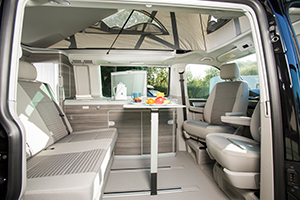I was fortunate enough to run a VW California for six months a full decade ago. Back then, the revised T5 Transporter had just been launched, and looking back at my notes it’s interesting to see what’s changed and what’s remained the same ten years on.
 The California’s not really a van conversion – instead, it rolls off VW’s factory lines as a complete camper and as a result has a level of fit and finish you’d expect in a luxury car.
The California’s not really a van conversion – instead, it rolls off VW’s factory lines as a complete camper and as a result has a level of fit and finish you’d expect in a luxury car.
My kids love the fact the rear passenger bench is adjustable. The angle of the seat back can be raked, plus the whole bench slides on runners so the kids can be as near or as far from parents in the cab seats as suits everyone.
The sliding entry door is still on the UK driver’s side, and this remains a problem for some, who maintain that rear passengers may have to exit the vehicle into traffic when parked on the roadside in the direction of traffic flow.
The electro-hydraulic elevating roof, which raise and lowers at the push of a button with the engine running was brilliant a decade ago and remains so.
 The layout remains a VW camper classic – nearside kitchenette with top-loading fridge, two-burner gas hob and sink, plus a rock-and-roll style rear seat bench that becomes a double bed. Not all campers offer a roof bed though, and the California’s is one of the best. Unlike many rivals, it’s a one-piece slatted-frame base on gas struts, rather than drop-in boards or similar. There’s still no elegant solution to getting in and out of it, though, other than clambering on the cab seats.
The layout remains a VW camper classic – nearside kitchenette with top-loading fridge, two-burner gas hob and sink, plus a rock-and-roll style rear seat bench that becomes a double bed. Not all campers offer a roof bed though, and the California’s is one of the best. Unlike many rivals, it’s a one-piece slatted-frame base on gas struts, rather than drop-in boards or similar. There’s still no elegant solution to getting in and out of it, though, other than clambering on the cab seats.
But otherwise, the living quarters represent a feat of space-saving design brilliance: camping chairs zip into a tailgate pocket, a freestanding table clips into the sliding entry door, a kitchenette table on a sliding rail is concealed alongside the sofa bench when not in use. Plus the rear passenger head restraints fold completely when not in use.
All this was brilliant ten years ago, and remains so today. One thing I don’t remember, though, was the rail adapted to accommodate other accessories such as towel hooks and cup holders. It’s a neat addition.
 The gas locker is unchanged – seated within the doughnut-shaped fresh water container, which I reckon is a smart use of space. And the release taps for the fresh and waste tanks remain inside the van. The shower attachment for hosing off muddy gear is a useful accessory too.
The gas locker is unchanged – seated within the doughnut-shaped fresh water container, which I reckon is a smart use of space. And the release taps for the fresh and waste tanks remain inside the van. The shower attachment for hosing off muddy gear is a useful accessory too.
To my mind, the standout improvement VW has made in the last ten years is to the cab screens. In the old days the standard kit included loose-fit push-on frame inserts for the cab door windows and for the windscreen a single piece of fabric that required tent-style poles to hold it rigid and in place. Thankfully the built-in concertina blinds now come as standard.
While the grey interior colour scheme – unchanged over the years – still divides opinion, I reckon that the California continues to set the standard for campervans.
VW California Ocean 2.0 TDI 150PS
Price as tested £56,697
Also check out our in depth look at the VW California in our video here.